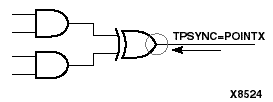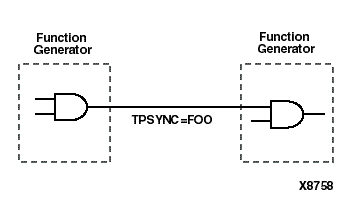There are situations where a particular point or set of points in your design needs to be flagged for reference in subsequent timing specifications. Timing points are used for these specifications.
There are two types of timing points.
The following sections describe how these timing points are specified in a schematic. The syntax for specifying TPSYNC and TPTHRU constraints in a UCF or NCF constraints file is described in the “Attributes, Constraints, and Carry Logic” chapter of the Libraries Guide.
There are cases where the timing of a design must be defined from or to a point in the design that is not a flip-flop, latch, RAM or I/O pad. For example, you might want to specify a point at the output of a latch defined using a function generator instead of a latch symbol. The TPSYNC timing point identifies one or a group of these points.
A TPSYNC attribute has the following syntax.
Schematic syntax
TPSYNC = identifier
UCF syntax
{NET | PIN | INST} TPSYNC= identifier;
identifier is a name that is used in timing specifications in the same way that groups are used. The same identifier can be used on several points which are then treated as a group from the point of view of timing analysis. The identifier must be different from any identifier used for a TNM attribute.
The way a TPSYNC timing point is used depends on the object to which it is attached.

Figure 4.17 TPSYNCs Attached to Macro Pins |

The use of a TPSYNC timing point to define a synchronous point in a design implies that the flagged point cannot be merged into a function generator. For example, consider the following diagram.

In this example, because of the TPSYNC definition, the two gates cannot be merged into a single function generator.
The TPTHRU attribute defines an intermediate point in a path. A point or group defined with TPTHRU attributes is used in detailed timing specifications.
A TPTHRU attribute has the following syntax.
TPTHRU = identifier
identifier is a name that is used in timing specifications in the same way that groups are used. The same identifier can be used on several points which are then treated as a group from the point of view of timing analysis.
The identifier must be different from any identifier used for a TNM attribute or TPSYNC.
Timing specifications using TPTHRU groups are described in the “Specifying Time Delay in TS Attributes” section.